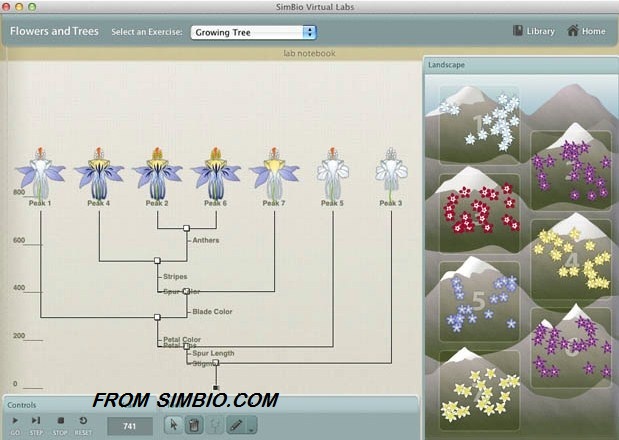You hear about evolution
frequently in the media today. Recent court cases about teaching
of evolution and intelligent design keep the topic in the
spotlight. Through your coursework and discussions, you are
beginning to understand the nature of science and how scientific evidence forms the basis for the theory of evolution. In this assignment you will focus on a key piece of evidence for evolutionary theory; specifically, traits of organisms and what they tell us about species' relatedness.
 For two class sessions you will study how character traits are used to determine locations of species on evolutionary trees. Your studies will be based on actual research conducted by Whittall and Hodges (2007) on columbine plants which are found throughout the northern hemisphere. Using traits of columbine flowers of differing species, you will test hypotheses about change in species over time. Initially you will learn how to recognize patterns among different traits in separate populations and how those can be used to form an evolutionary tree. You will also learn how to interpret the evolutionary history of taxa by examining information in a phylogenetic tree and how to construct a phylogenetic tree. Lastly, you will apply the methods learned to reconstruct the evolutionary history of several separate populations of columbine plants. Throughout these activities you will continue to use and build your skills of conducting scientific inquiry. For two class sessions you will study how character traits are used to determine locations of species on evolutionary trees. Your studies will be based on actual research conducted by Whittall and Hodges (2007) on columbine plants which are found throughout the northern hemisphere. Using traits of columbine flowers of differing species, you will test hypotheses about change in species over time. Initially you will learn how to recognize patterns among different traits in separate populations and how those can be used to form an evolutionary tree. You will also learn how to interpret the evolutionary history of taxa by examining information in a phylogenetic tree and how to construct a phylogenetic tree. Lastly, you will apply the methods learned to reconstruct the evolutionary history of several separate populations of columbine plants. Throughout these activities you will continue to use and build your skills of conducting scientific inquiry.
Work with a partner as you proceed through the different exercises of the simulation, discussing your ideas about the tasks assigned. When you get to the graded questions at the end of the simulation, complete those individually. |
 For two class sessions you will study how character traits are used to determine locations of species on evolutionary trees. Your studies will be based on actual research conducted by Whittall and Hodges (2007) on columbine plants which are found throughout the northern hemisphere. Using traits of columbine flowers of differing species, you will test hypotheses about change in species over time. Initially you will learn how to recognize patterns among different traits in separate populations and how those can be used to form an evolutionary tree. You will also learn how to interpret the evolutionary history of taxa by examining information in a phylogenetic tree and how to construct a phylogenetic tree. Lastly, you will apply the methods learned to reconstruct the evolutionary history of several separate populations of columbine plants. Throughout these activities you will continue to use and build your skills of conducting scientific inquiry.
For two class sessions you will study how character traits are used to determine locations of species on evolutionary trees. Your studies will be based on actual research conducted by Whittall and Hodges (2007) on columbine plants which are found throughout the northern hemisphere. Using traits of columbine flowers of differing species, you will test hypotheses about change in species over time. Initially you will learn how to recognize patterns among different traits in separate populations and how those can be used to form an evolutionary tree. You will also learn how to interpret the evolutionary history of taxa by examining information in a phylogenetic tree and how to construct a phylogenetic tree. Lastly, you will apply the methods learned to reconstruct the evolutionary history of several separate populations of columbine plants. Throughout these activities you will continue to use and build your skills of conducting scientific inquiry.